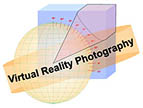

![]() Ask the VR Photography Experts
Ask the VR Photography Experts
![]()
Q: Can you suggest a good ultra wide angle lens, which can do double duty on a film SLR as well as on a Nikon D1x or D100 for cubics or ultra high FOV cylindricals. I’m looking at the the Nikon 14/15mm vs. 16mm lens for VR?
![]()
A: Keep in mind that the Nikon 14mm, when used on a D1x or even the newer D2 series digital Nikons, will only have the vertical field of view (fovy) equivalent of a 21mm lens on a 35mm camera, due to the smaller image sensor size of the digital cameras (about 1.5x effective focal length magnification). A 15mm has the fovy of a 23-24mm lens when used on a D1x.
The newer Nikon 14mm lens is far superior to the older 15mm (which Nikon no longer makes), as it is almost a full stop faster (f/2.8 instead of f/3.5) and is autofocus, instead of manual focus. It is also a more modern lens design, and amazingly, is cheaper than the 15mm (which is increasingly hard to find). A new 14mm sells for about $1,400 via US mail order, while the 15mm usually sells for $1,700-$2,000 used.
Personally, I dislike using the 15mm, because it picks up so much flare and has no effective way to attach color correction filters (the newer 14mm has gelatin filter holder clips on the rear of the lens). I much prefer the 18mm for most QTVR panoramas, as you can add a lens shade to the front of it, as well as threaded 77mm filters when you want/need them. I've not used the 14mm much yet, other than to test it under trade show floor lighting. It picks up far less flare than the 15mm, and the extra millimeter in reduced focal length adds about 4 degrees to the vertical field of view (fovy).
| 14mm | = | 104 degrees |
| 15mm | = | 100 degrees |
| 18mm | = | 90 degrees |
| 14mm | = | 80 degrees |
| 15mm | = | 77 degrees |
| 18mm | = | 67 degrees |
![]()
The Nikkor 16mm is a fisheye lens, whereas the 14mm, 15mm and 18mm are rectilinear lenses. The fisheye lens means that you'll probably need to run the images through a digital "correction" process before you try to stitch them with most VR authoring software like QTVRAS, RealViz's Stitcher or the VR Worx. You can do this with Ken Turkowski's DeFish or Helmut Dersch's tools, but this does add another post processing step to every source image in your panorama authoring.
I do 90 percent of my panorama shooting with an 18mm lens on a 35mm film camera. Most of the rest of it is done with the 15mm (interiors and other confined spaces). I find I use my 16mm fisheye far more often for traditional photography than I do for VR, but it's a very nice lens to have, as it is small, lightweight and costs between $700 and $800 in the US. I've had little success using it for VR panoramas, but I have to say I haven't put a lot of effort into trying to standardize my correction specs for it in DeFish.
The 14mm, 15mm and 18mm are all effective for shooting multi-row cubic images (for stitching with RealViz's Stitcher).
If only we could get a good stitcher that would accept the 16mm fisheye images, the whole process would become a lot easier. In that event, I would more heartily recommend the 16mm because you could shoot 360-degree panorama sequences in only 4-6 shots, and it would give you a single-row fovy of about 140 degrees.
- Scott Highton